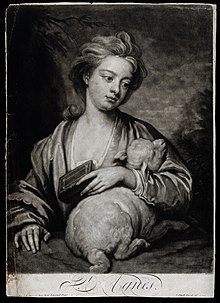
Back نقش تظليلي Arabic Мецотинто Bulgarian Mezzotinta BS Manera negra Catalan Mezzotinta Czech Mezzotinte Danish Schabkunst German Grabado a media tinta Spanish Metsotinto Estonian Kedarrezko grabatu (mezzotint) Basque

| Part of a series on the |
| History of printing |
|---|
 |
Mezzotint is a monochrome printmaking process of the intaglio family. It was the first printing process that yielded half-tones without using line- or dot-based techniques like hatching, cross-hatching or stipple. Mezzotint achieves tonality by roughening a metal plate with thousands of little dots made by a metal tool with small teeth, called a "rocker". In printing, the tiny pits in the plate retain the ink when the face of the plate is wiped clean. This technique can achieve a high level of quality and richness in the print, and produce a furniture print which is large and bold enough to be framed and hung effectively in a room.[2]
Mezzotint is often combined with other intaglio techniques, usually etching and engraving, including stipple engraving. The process was especially widely used in England from the eighteenth century, and in France was called la manière anglais (“the English manner”). Until the 20th century it has mostly been used for reproductive prints to reproduce portraits and other paintings, rather than for original compositions.[3] From the mid-18th century it was somewhat in competition with the other main tonal technique of the day, aquatint.
Since the mid-nineteenth century it has been relatively little used, as lithography and other techniques produced comparable results more easily.[4] Sir Frank Short (1857–1945) was an important pioneer of the mezzotint revival in the United Kingdom along with Peter Ilsted (1864–1933) in Denmark.
Mezzotint is known for the luxurious quality of its tones: first, because an evenly, finely roughened surface holds a lot of ink, allowing deep solid colours to be printed; secondly because the process of smoothing the plate with burin, burnisher and scraper allows fine gradations in tone to be developed. The scraper is a triangular ended tool, and the burnisher has a smooth round end – not unlike many spoon handles.[5]